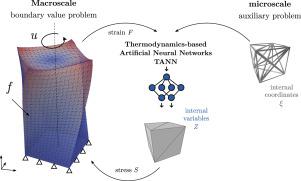Computer Methods in Applied Mechanics and Engineering ( IF 7.2 ) Pub Date : 2022-06-18 , DOI: 10.1016/j.cma.2022.115190 Filippo Masi , Ioannis Stefanou

|
The mechanical behavior of inelastic materials with microstructure is very complex and hard to grasp with heuristic, empirical constitutive models. For this purpose, multiscale, homogenization approaches are often used for performing reliable, accurate predictions of the macroscopic mechanical behavior of solids and structures. Nevertheless, the calculation cost of such approaches is extremely high and prohibitive for real-scale applications involving inelastic materials.
Recently, data-driven approaches based on machine learning and, in particular, deep learning have risen as a promising alternative to replace ad-hoc constitutive laws and speed-up multiscale numerical methods. However, such approaches require huge amounts of high quality data, fail to give reliable predictions outside the training range and they lack a rigorous frame based on the laws of physics and thermodynamics. As a result, their application to model materials with complex microstructure in inelasticity is not yet established.
Here, we propose the so-called Thermodynamics-based Artificial Neural Networks (TANN) for the constitutive modeling of materials with inelastic and complex microstructure. Our approach integrates thermodynamics-aware dimensionality reduction techniques and thermodynamics-based deep neural networks to identify, in an autonomous way, the constitutive laws and discover the internal state variables of complex inelastic materials. The ability of TANN in delivering high-fidelity, physically consistent predictions is demonstrated through several examples both at the microscopic and macroscopic scale.
The efficiency and accuracy of TANN in predicting the average and local stress–strain response, the free-energy and the dissipation rate is demonstrated for both regular and perturbed two- and three-dimensional lattice microstructures in inelasticity. TANN manage to identify the internal state variables that characterize the inelastic deformation of the complex microstructural fields. These internal state variables are then used to reconstruct the microdeformation fields of the microstructure at a given state. Finally, a double-scale homogenization scheme (FEMTANN) is used to solve a large scale boundary value problem. The high performance of the homogenized model using TANN is illustrated through detailed comparisons with microstructural calculations at large scale. An excellent agreement is shown for a variety of monotonous and cyclic stress–strain paths.
中文翻译:

使用基于热力学的人工神经网络 (TANN) 对非弹性材料进行多尺度建模
具有微观结构的非弹性材料的力学行为非常复杂,很难用启发式的经验本构模型来掌握。为此,多尺度均匀化方法通常用于对固体和结构的宏观力学行为进行可靠、准确的预测。然而,这种方法的计算成本非常高,并且对于涉及非弹性材料的实际应用来说是令人望而却步的。
最近,基于机器学习,特别是深度学习的数据驱动方法已成为替代临时本构定律和加速多尺度数值方法的有希望的替代方法。然而,这种方法需要大量高质量的数据,无法在训练范围之外给出可靠的预测,并且缺乏基于物理和热力学定律的严格框架。因此,它们在非弹性中具有复杂微观结构的材料模型中的应用尚未建立。
在这里,我们提出了所谓的基于热力学的人工神经网络 (TANN),用于对具有非弹性和复杂微观结构的材料进行本构建模。我们的方法集成了热力学感知降维技术和基于热力学的深度神经网络,以自主方式识别本构定律并发现复杂非弹性材料的内部状态变量。TANN 在提供高保真、物理一致的预测方面的能力通过几个微观和宏观尺度的例子得到证明。
TANN 在预测平均和局部应力-应变响应、自由能和耗散率方面的效率和准确性在非弹性中的规则和扰动二维和三维晶格微结构中得到证明。TANN 设法识别出表征复杂微结构场的非弹性变形的内部状态变量。然后使用这些内部状态变量来重建给定状态下微结构的微变形场。最后,双尺度均匀化方案(FEMTANN) 用于解决大规模边值问题。通过与大规模微观结构计算的详细比较,说明了使用 TANN 的同质化模型的高性能。对于各种单调和循环的应力-应变路径,显示出极好的一致性。



























 京公网安备 11010802027423号
京公网安备 11010802027423号